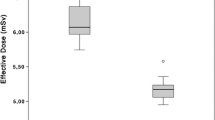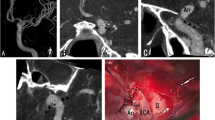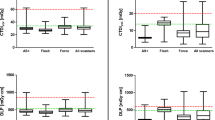Abstract
Objectives
Intraoperative CT (iCT) angiography of the brain with stereotactic frames is an integral part of navigated neurosurgery. Validated data regarding radiation dose and image quality in these special examinations are not available. We therefore investigated two iCT protocols in this IRB-approved study.
Methods
Retrospective analysis of patients, who received a cerebral stereotactic iCT angiography on a 128 slice CT scanner between February 2016 and December 2017. In group A, automated tube current modulation (ATCM; reference value 410 mAs) and automated tube voltage selection (reference value 120 kV) were enabled, and only examinations with a selected voltage of 120 kV were included. In group B, fixed parameters were applied (300 mAs, 120 kV). Radiation dose was measured by assessing the volumetric CT dose index (CTDIvol), dose length product (DLP) and effective dose (ED). Signal-to-noise ratio (SNR) and image noise were assessed for objective image quality, visibility of arteries and grey-white differentiation for subjective image quality.
Results
Two hundred patients (n = 100 in each group) were included. In group A, median selected tube current was 643 mAs (group B, 300 mAs; p < 0.001). Median values of CTDIvol, DLP and ED were 91.54 mGy, 1561 mGy cm and 2.97 mSv in group A, and 43.15 mGy, 769 mGy cm and 1.46 mSv in group B (p < 0.001). Image quality did not significantly differ between groups (p > 0.05).
Conclusions
ATCM yielded disproportionally high radiation dose due to substantial tube current increase at the frame level, while image quality did not improve. Thus, ATCM should preferentially be disabled.
Key Points
• Automated tube current modulation (ATCM) yields disproportionally high radiation dose in intraoperative CT angiography of the brain with stereotactic head frames.
• ATCM does not improve overall image quality in these special examinations.
• ATCM is not yet optimised for CT angiography of the brain with major extracorporeal foreign materials within the scan range.



Similar content being viewed by others
Abbreviations
- ADM:
-
Automated dose modulation
- ATCM:
-
Automated tube current modulation
- CTDIvol :
-
Volumetric computed tomography dose index
- DLP:
-
Dose length product
- ED:
-
Effective dose
- FET-PET:
-
O-(2-18F-fluoroethyl)-l-tyrosine positron emission tomography
- HU:
-
Hounsfield unit
- iCT:
-
Intraoperative computed tomography
- MAR:
-
Metal artefact reduction
- SD:
-
Standard deviation
- SNR:
-
Signal-to-noise ratio
References
Shalit MN, Israeli Y, Matz S, Cohen ML (1982) Experience with intraoperative CT scanning in brain tumors. Surg Neurol 17:376–382
Can SM, Turkmenoglu ON, Tanik C et al (2017) Computerized tomography-guided stereotactic biopsy of intracranial lesions: report of 500 consecutive cases. Turk Neurosurg 27:395–400
Kreth FW, Muacevic A, Medele R, Bise K, Meyer T, Reulen HJ (2001) The risk of haemorrhage after image guided stereotactic biopsy of intra-axial brain tumours--a prospective study. Acta Neurochir (Wien) 143:539–545
Rachinger W, Grau S, Holtmannspötter M, Herms J, Tonn JC, Kreth FW (2009) Serial stereotactic biopsy of brainstem lesions in adults improves diagnostic accuracy compared with MRI only. J Neurol Neurosurg Psychiatry 80:1134–1139
Eigenbrod S, Trabold R, Brucker D et al (2014) Molecular stereotactic biopsy technique improves diagnostic accuracy and enables personalized treatment strategies in glioma patients. Acta Neurochir (Wien) 156:1427–1440
Grasbon-Frodl EM, Kreth FW, Ruiter M et al (2007) Intratumoral homogeneity of MGMT promoter hypermethylation as demonstrated in serial stereotactic specimens from anaplastic astrocytomas and glioblastomas. Int J Cancer 121:2458–2464
Schichor C, Rachinger W, Morhard D et al (2010) Intraoperative computed tomography angiography with computed tomography perfusion imaging in vascular neurosurgery: feasibility of a new concept. J Neurosurg 11:722–728
Terpolilli NA, Rachinger W, Kunz M et al (2016) Orbit-associated tumors: navigation and control of resection using intraoperative computed tomography. J Neurosurg 124:1319–1327
Söderberg M, Gunnarsson M (2010) Automatic exposure control in computed tomography--an evaluation of systems from different manufacturers. Acta Radiol 51:625–634
Sabel BO, Buric K, Karara N et al (2016) High-pitch CT pulmonary angiography in third generation dual-source CT: image quality in an unselected patient population. PLoS One 11:e0146949
Wichmann JL, Hardie AD, Schoepf UJ et al (2017) Single- and dual-energy CT of the abdomen: comparison of radiation dose and image quality of 2nd and 3rd generation dual-source CT. Eur Radiol 27:642–650
De Cecco CN, Darnell A, Macías N et al (2013) Second-generation dual-energy computed tomography of the abdomen: radiation dose comparison with 64- and 128-row single-energy acquisition. J Comput Assist Tomogr 37:543–546
Spearman JV, Schoepf UJ, Rottenkolber M et al (2016) Effect of automated attenuation-based tube voltage selection on radiation dose at CT: an observational study on a global scale. Radiology 279:167–174
Geyer LL, Schoepf UJ, Meinel FG et al (2015) State of the art: iterative CT reconstruction techniques. Radiology 276:339–357
Haubenreisser H, Fink C, Nance JW Jr et al (2014) Feasibility of slice width reduction for spiral cranial computed tomography using iterative image reconstruction. Eur J Radiol 83:964–969
Guziński M, Waszczuk Ł, Sąsiadek MJ (2016) Head CT: image quality improvement of posterior fossa and radiation dose reduction with ASiR - comparative studies of CT head examinations. Eur Radiol 26:3691–3696
Wenz H, Maros ME, Meyer M et al (2016) Intra-individual diagnostic image quality and organ-specific-radiation dose comparison between spiral cCT with iterative image reconstruction and z-axis automated tube current modulation and sequential cCT. Eur J Radiol Open 3:182–190
Christner JA, Braun NN, Jacobsen MC, Carter RE, Kofler JM, McCollough CH (2012) Size-specific dose estimates for adult patients at CT of the torso. Radiology 265:841–847
Aissa J, Boos J, Schleich C et al (2017) Metal artifact reduction in computed tomography after deep brain stimulation electrode placement using iterative reconstructions. Invest Radiol 52:18–22
Bier G, Bongers MN, Hempel JM et al (2017) Follow-up CT and CT angiography after intracranial aneurysm clipping and coiling-improved image quality by iterative metal artifact reduction. Neuroradiology 59:649–654
Morsbach F, Wurnig M, Kunz DM et al (2013) Metal artefact reduction from dental hardware in carotid CT angiography using iterative reconstructions. Eur Radiol 23:2687–2694
Deak PD, Smal Y, Kalender WA (2010) Multisection CT protocols: sex- and age-specific conversion factors used to determine effective dose from dose-length product. Radiology 257:158–166
(2007) The 2007 recommendations of the International Commission on Radiological Protection. ICRP publication 103. Ann ICRP 37:1–332
Suntharalingam S, Wetter A, Guberina N et al (2016) Impact of the scout view orientation on the radiation exposure and image quality in thoracic and abdominal CT. Eur Radiol 26:4072–4079
Takeyama N, Kuroki K, Hayashi T et al (2012) Cerebral CT angiography using a small volume of concentrated contrast material with a test injection method: optimal scan delay for quantitative and qualitative performance. Br J Radiol 85:e748–e755
Chen GZ, Zhang LJ, Schoepf UJ et al (2015) Radiation dose and image quality of 70 kVp cerebral CT angiography with optimized sinogram-affirmed iterative reconstruction: comparison with 120 kVp cerebral CT angiography. Eur Radiol 25:1453–1463
Federal Office for Radiation Protection (2016) Publication of updated diagnostic reference levels for diagnostic and interventional X-ray examinations [Article in German]. Federal Office for Radiation Protection, Berlin. Available via http://www.bfs.de/SharedDocs/Downloads/BfS/DE/fachinfo/ion/drw-roentgen.pdf?__blob=publicationFile&v=9. Accessed 23 Oct 2018
Chen Y, Zhang X, Xue H et al (2017) Head and neck angiography at 70 kVp with a third-generation dual-source CT system in patients: comparison with 100 kVp. Neuroradiology 59:1071–1081
Ni QQ, Chen GZ, Schoepf UJ et al (2016) Cerebral CTA with low tube voltage and low contrast material volume for detection of intracranial aneurysms. AJNR Am J Neuroradiol. https://doi.org/10.3174/ajnr.A4803
Chen GZ, Fang XK, Zhou CS, Zhang LJ, Lu GM (2017) Cerebral CT angiography with iterative reconstruction at 70kVp and 30mL iodinated contrast agent: initial experience. Eur J Radiol 88:102–108
Yu L, Li H, Mueller J et al (2009) Metal artifact reduction from reformatted projections for hip prostheses in multislice helical computed tomography: techniques and initial clinical results. Invest Radiol 44:691–696
Kachelriess M, Watzke O, Kalender WA (2001) Generalized multi-dimensional adaptive filtering for conventional and spiral single-slice, multi-slice, and cone-beam CT. Med Phys 28:475–490
Meinel FG, Bischoff B, Zhang Q, Bamberg F, Reiser MF, Johnson TR (2012) Metal artifact reduction by dual-energy computed tomography using energetic extrapolation: a systematically optimized protocol. Invest Radiol 47:406–414
Wuest W, May MS, Brand M et al (2015) Improved image quality in head and neck CT using a 3D iterative approach to reduce metal artifact. AJNR Am J Neuroradiol 36:1988–1993
Coursey C, Frush DP, Yoshizumi T, Toncheva G, Nguyen G, Greenberg SB (2008) Pediatric chest MDCT using tube current modulation: effect on radiation dose with breast shielding. AJR Am J Roentgenol 190:W54–W61
Acknowledgements
Part of the data was presented orally at the ECR 2018 in Vienna, Austria, and the XXI Symposium Neuroradiologicum 2018 in Taipei, Taiwan.
Funding
The authors state that this work has not received any funding.
Author information
Authors and Affiliations
Corresponding author
Ethics declarations
Guarantor
The scientific guarantor of this publication is PD Dr. Christoph G. Trumm.
Conflict of interest
The authors of this manuscript declare no relationships with any companies, whose products or services may be related to the subject matter of the article.
Statistics and biometry
PD Dr. Robert Stahl kindly provided statistical advice for this manuscript.
Informed consent
Written informed consent was waived by the Institutional Review Board.
Ethical approval
Institutional Review Board approval was obtained.
Methodology
• retrospective
• diagnostic study
• performed at one institution
Additional information
Publisher’s Note Springer Nature remains neutral with regard to jurisdictional claims in published maps and institutional affiliations.
Rights and permissions
About this article
Cite this article
Forbrig, R., Geyer, L.L., Stahl, R. et al. Radiation dose and image quality in intraoperative CT (iCT) angiography of the brain with stereotactic head frames. Eur Radiol 29, 2859–2867 (2019). https://doi.org/10.1007/s00330-018-5930-0
Received:
Revised:
Accepted:
Published:
Issue Date:
DOI: https://doi.org/10.1007/s00330-018-5930-0




